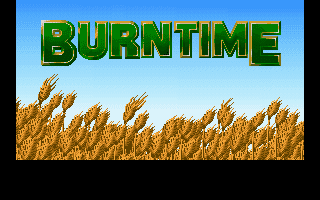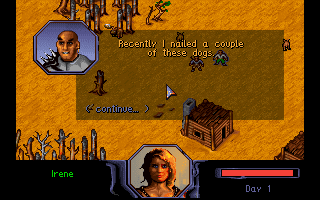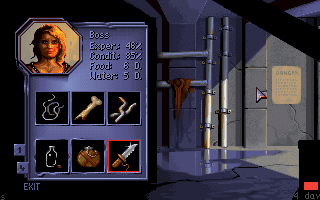In the last session, the party learned about a mysterious figure named Dagolar who created the Tari and the skulls that housed the Tari ancestors. We learned that to get into his domain, we would need to use the Staff of Parting in the northeast corner of the dungeon. We did that, which drained the water there and allowed us to access a new part of the sewers.
I think Dagolar's area was entirely optional--nothing that happened there was required for us to leave the sewers and continue the main quest. It was fun anyway. Despite his relatively benign act of creating the Tari, Dagolar was a corrupt, twisted mage whose domain was full of pain, torture, and horrendous experiments. A particular creation called "Dagolar's Slimes" patrolled the corridors. They hit hard, cast "Web," and had damaging psionics. Although the manual claims they have "nil" magic resistance, clearly that wasn't true because none of my spells seemed to affect them. Human guards, zombies, and shadows--which could only be damaged by magic weapons and spells--were the other primary enemies.
There's something I don't quite understand about combat. Sometimes when you encounter an enemy, the game immediately goes into combat mode. Other times, it remains in normal mode until the enemy reaches you. During those times, if you time it perfectly, you can "attack" them from regular mode and do some damage--sometimes killing them--before combat even begins. Other times, you can walk right up to enemies who seem to remain ignorant of your presence (even if you have no stealth or invisibility active) and initiate combat by, again, attacking them from outside combat, and often killing them immediately. It's a nice bonus when either of the latter things happens, but I don't quite understand the variances.
 |
| The Master of the Water Gate encourages us to kill some guards. |
After we fought a few slimes, we opened a door and ran into a talking rat, Master of the Water Gate. Eager to escape his slavery, he offered to help us kill Dagolar. I don't think he was a Tari. He helped us in the next few combats and had some commentary about the things we saw in each of the rooms we explored. He told us that to pass through something called the Door of Eyes, each character would need to be wearing a special necklace. We got them by killing a few guards.
On the other side of the Door of Eyes, we ran into Keldar, who the rat told us was Dagolar's second-in-command. "He is insane!" Keldar did seem to be a little off. He insisted on writing our names in a book and then asked how we wanted to die. When we insisted that we didn't want to die, he teleported out of the room and left us to kill a bunch of slimes, zombies, and shadows. This happened a second time in a later room. Unfortunately, the Master of the Water Gate was killed in the first of these combats and never got to experience his freedom.
 |
| Keldar had a screw loose. |
Every room had evidence of Dagolar's crimes. Skeletons were everywhere (some with minor treasures), along with iron maidens, racks, and other instruments of torture. One room had statues of people fused together in grotesque masses. They cried out in pain saying that Dagolar had sentenced them to torture until the end of time. I couldn't seem to do anything for them, not even after Dagolar was dead.
We found a room full of bottles of "Dagolar's powder" and a vat for mixing them. Mixing one bottle produced a zombie that joined our party. A second bottle caused Violencia to drop all her inventory. A third teleported us to another part of the dungeon. We stopped after that.
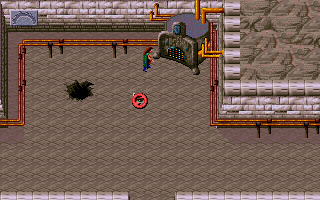 |
| There were several contraptions like this where I couldn't find anything to do, but I wonder if there was something to do just the same. |
One chamber was marked with a plaque that read: "Goburnix, my only mistake." Goburnix was Dagolar's brother; we had found his journal in the Tari warrens, outlining his quest to find Dagolar and stop his abominations. He had apparently failed, as the room contained the living husk of Goburnix, a zombie barely capable of thought or speech. But he was non-hostile, and with gestures and slurred words, he indicated that he wanted to come with us to find Dagolar. A scroll on his person was written from Dagolar to Goburnix, apologizing for what he had done, asking forgiveness, and promising to face Goburnix again when he'd built up the courage.
 |
| As usual, the party had "evil" (or at least impatient) options. |
Dagolar's chambers were beyond an archway of fire, but Goburnix walked through and activated the pressure plate that allowed us to pass safely.
We encountered Dagolar in the northwest section of the dungeon. He was appalled to see Goburnix with us, and even more appalled when Goburnix started approaching his brother, his arms open wide for a hug. Before Goburnix could reach his brother, Dagolar blasted him to ash. He started ranting at the party for involving Goburnix. Keldar, also in the room, objected by reminding Dagolar that, "it was only a rotten corpse." Dagolar responded by blasting Keldar to ash, too. (I assume that if I hadn't picked up Goburnix, the battle would have been harder with Keldar's involvement.) Dagolar then summoned 10 slimes and attacked us.
Yester, my preserver, had achieved "Fireball" (of course it was the first Level 3 spell I selected) a few combats ago, and the room was laid out perfectly for it. Practically quivering with glee, I called it up and cast it:
Well. That was disappointing. The slimes are apparently immune to "Fireball." Only Dagolar was injured. That was enough, though. Unable to cast spells his first round, he unwisely chose to charge us in melee combat, and Sunstroke pounded him to goo. Rather than face the 10 slimes in open combat, we retreated down the corridor to another room and dealt with them one at a time as they came around the corner. "Prayer," "Bless," "Barkskin," and "Aid" all helped.
When we were done, we looted Dagolar's corpse and the rest of the area. Dagolar had a "Living Cloak" that keeps "Intertial Barrier" going constantly, which halves damage from certain attacks. He had a wand that casts "Control Body" and a +3 dagger. There were plenty of gems, rings, and piles of coin, too.
There were lots of empty rooms in the southwest part of the dungeon, and I suspect that if I'd adopted a different exploration pattern, I would have encountered things in these rooms before killing Dagolar. I wonder what would have happened if I'd reached him with the Master of the Water Gate or if I'd not picked up Goburnix. I'll have to remember to look these alternate paths up in a cluebook later. Until then, suffice to say that I love that the game gives so many potential options for these encounters, in both a macro sense (the order that you explore the map, big decisions) and a micro sense (dialogue and encounter options).
We returned to the warrens and took another exit, emerging from the sewers into the sunshine at last. For a game set on an apocalyptic wasteland, Dark Sun has sure taken its time actually exposing us to that wasteland. In fact, it would continue to take longer, as we emerged into relatively lush fields of wheat and other crops, tended by a bunch of nameless serfs "too old to fight in the pits and too weak to help with the pyramid." They told us we were in the fields outside Draj. They warned us that the perimeter is patrolled by guards--increasing numbers lately, as the sorcerer-king seems to be preparing some major campaign. There are vicious beasts in the wilderness outside, even if we could get past the guards. When asked for help, they directed us to "Old One-Eye."
Although we were outdoors, we couldn't just walk across the fields. Mounds and canals kept us to fixed paths, much like dungeon corridors. The outdoors was really just a dungeon with outdoor textures.
We tangled with a few (easy) guards as we looked around for Old One Eye. We eventually found him in the center of the map. He told us there are two ways out of the area: kill the guards or knock down a weak spot in the eastern part of the bone wall. We chose the second, and he led us to the location, asking us to "come back and destroy this blasted city." He also gave us a scroll of "Armor."
We managed to bash down the wall just fine, but we had made such short work of the guards that I figured we might as well clear them out of the area. Also, I hadn't really explored everything. I'm glad I took the time, because on the west side of the map, I found my first "shop"--a serf selling magical crops. He had pears capable of "Cure Light Wounds," grapes of "Bless," lemons that restored psionic points, "Barkskin" corn, and grapes of "Neutralize Poison." Moreover, he bought all the extra junk I'd been lugging around. I sold him everything I could spare and bought a healing pear. I wouldn't mind if the interface had offered an easier option than clicking on each item and then dragging it over to the "sell" button.
 |
| The manual said water was more valuable than gold, but this guy will only give me one coin for a pot of it. |
Elsewhere, a serf wanted us to agree to let him follow us out in exchange for a gem that someone had stolen from an obelisk in the area. We agreed. The game let us put the gem back in the obelisk, but I'm not sure what it accomplished, if anything. Maybe we're just meant to sell the gem.
After we'd wiped out the guards, we took the north exit. The serf bid us farewell and said he could handle the wilderness, but his methods were too technical for us "barbarians." He was then immediately eaten by a bulette (I guess that bulette had a buffet!) that we had to kill.
Just outside the exit, we found a body with a scroll on it. The scroll's message had been written by someone in the palace named Rajak. The message warned that the armies amassing in Draj are "not for some far away campaign," but rather to destroy the free villages in the area. Rajak begs the recipient to flee, as "I see no band of 'heroes' that will come and save us from the might of Draj's army." This apparently refers to a prophecy from a "visionary."
An old man immediately wandered over after we'd read the scroll. He introduced himself as Egrus. He had read the message, too, and said that the carrier had been bound for the village of Teaquetzl to the north. He suggested that we forget we read the scroll, as nothing can stop the sorcerer-king's armies. We told him we would, but that would give us nothing to do for the rest of the game.
We wandered north, fought a couple of easy enemies called "sand howlers," and met a lizardwoman named Laussa, "of the Grey Isles tribe." (The "isles" are boulders poking out of the sand.) She had left her tribe after some human merchants engineered a coup that left the former leader, Laussa's lover, dead. Laussa is seeking a new tribe, away from humans. I couldn't find any way to help her, and she kept referring to us as "prey," so I left via an eastern exit into a red-tinged area. I had frankly expected a world map to pop up once we were outside, but instead there seems to be a series of interconnected maps.
The red area was sparsely populated. In the southeast corner, I met an "animal trainer supreme" named Demothi. He was in the process of domesticating a large mastyrial, which is basically a giant scorpion. He had named it "Alita," intending to sell it to a tribe in "The Hinterlands." We had a dialogue option to ask to buy the beast, but Demothi wanted refined salt for it, and of course we didn't have any.
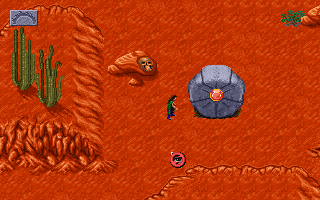 |
| No idea what these are about. |
As we walked away, an old man named Algernon approached, fawning over us for having escaped the Arena. He said that we must be "from the Veiled Alliance." When we protested that we'd never heard of the organization, he chuckled, assuming we were just keeping their secrets. He had something to say about each of the magic items we had collected. He "donated" two items to us as we left: a wand that can detect metal, and a gem for an obelisk in the area. As before, it fit into the obelisk's hole, but I still don't know what these things are for.
An elf named Notaku had set up a laboratory on the central mesa in the region, selling spell components for mages. He offered us 500 gold pieces to carry a bag of "ranike pith" to Father Garyn in Teaquetzl. He also said he'd buy any sand howler eyes and fire eel tongues that we found. Teaquetzl is reportedly one square west and one square north.
 |
| Notaku's sweet setup. |
We should have headed directly there, but the inscrutable exhortations of our souls drove us south instead, to another region of red sands. Shortly after we arrived, we ran into a group of "magera"--basically the orcs of this setting--escorting human prisoners to slavery. After a failed initial attempt to kill them without much preparation (they hit hard), we reloaded, buffed, and tried again. We used the old "catch 'em in a 'Grease' trap and fill them with arrows" trick and managed to kill the party.
The rescued slaves told us that the rest of their party was nearby, "with no supplies or defense!" We escorted the group back to their destroyed wagon but got trapped in a circle of NPCs--I couldn't find any way to get them to move out of the way--and I had to reload.
After we defeated the second group of magera, the grateful humans gave us a magic +1 bone hornblade. We had the option to tell them "I'm allying against Draj's army," which was news to us. They said they'd join us and asked where we should all meet. We responded Teaquetzl. I think I was supposed to visit Teaquetzl first. The game has so far been better about not allowing such plot developments outside of our exploration order.
As we crossed a bridge in this area, the game alerted us to a "corridor" beneath us. If we had a rope, it said, we could lower ourselves down. I didn't have a rope, so I left the area to the west, which took us back to the farmland and the bone gate we'd previously smashed. We headed back north, defeated a pack of wild muls led by a couple of defilers, rested at Egrus's camp, and continued on. We fought some more sand howlers, this time taking care to grab their eyes. Another north exit, we were in the town of Teaquetzl.
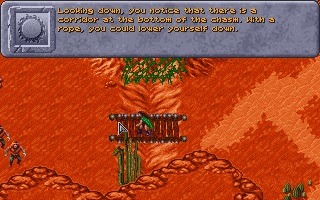 |
| Good thing we crossed the bridge! |
A guard posted at the entrance demanded our business; we said we were there to see Father Garyn, but there were other options that probably would have gotten us in. The guard said we should talk to Chahl, their leader and founder of the village. The guard let on that the town was more prosperous than most of the free desert villages because of a well that has never gone dry. He also told us about a crazed halfling called "the visionary" who's ranting about something.
In the council chambers, Chahl immediately welcomed us as the prophesied heroes (the Visionary
had apparently drawn them a picture). He and Kwerin, the chief
lieutenant, said that we're supposed to save them from an army coming
from Draj. Chahl thinks the solution is joining with the other gladiator
villages while Kwerin thinks Teaquetzl should try to stand alone.
Ignoring some more obnoxious dialogue options ("I have no wish to help you," etc.), we agreed to do our best. Chahl, overjoyed, assigned us a house (with "gifts") to the southeast. He suggested we visit the other villages while his people collected intelligence on Draj.
I'll cover more about Teaquetzl next time. A few miscellaneous notes until then:
- I haven't mentioned in previous entries that the game offers two methods of seeing the party while in exploration mode. In the default, the party is represented by only one of the four characters. You can switch among them with the number keys. But hit the 5 key, and all four party members appear, like they do in combat. Exploring in this mode reminds me strongly of Ultima VI, and I wonder if the developers weren't a little bit influenced by that game.
- I'm having some significant pathfinding issues in combat. I'll click on an enemy so a character will walk over and attack him, but the character will turn and walk in the opposite direction. Apparently, he can't find a direct path so he figures he'll circle the entire dungeon and come at the enemy from the rear. This happens even when there's a fairly obvious direct path.
- Chahl is said to have escaped from the fighting pits in "Nibenay." I can only imagine that Bethesda took the name of the region of Tamriel from this setting.
- The manual says that gladiators reach Level 8 at 150,000 experience points, but the character sheet for Violencia says that she'll hit the level at 125,000.
- As I close, Violencia is a Level 7 gladiator (out of 9). I had originally planned to dual her to a preserver or psionicist at Level 8, but I think maybe I'll just max her as a gladiator after all. That requires 300,000 experience points, and she's only earned 98,266 so far, so it's not exactly close. Sunstroke is a Level 6/6 fighter/cleric. Featherweight is a Level 6/7 ranger/thief. Yester is a Level 6/7 preserver/druid.
I'm still having a great time with the game. It's fast and fun with great encounters and combats. This would be a great game to replay on a higher difficulty level, once I have a good sense of the new enemies, spells, and combat rules.
As I mentioned in my Pool of Radiance entry, though, I think I still find Gold Box combat marginally better. That might still change as I get more expertise with Dark Sun's, but for now I feel that Sun has perspective issues (e.g., characters or monsters hidden behind other characters or monsters), pathfinding issues, and ambiguities that the Gold Box mercifully lacked. On the other hand, Dark Sun is a clear winner in its game world, character creation, NPCs, and quest design. Right now, I'm thinking it's possible that we're going to end this with a new "top game."
Time so far: 14 hours
























